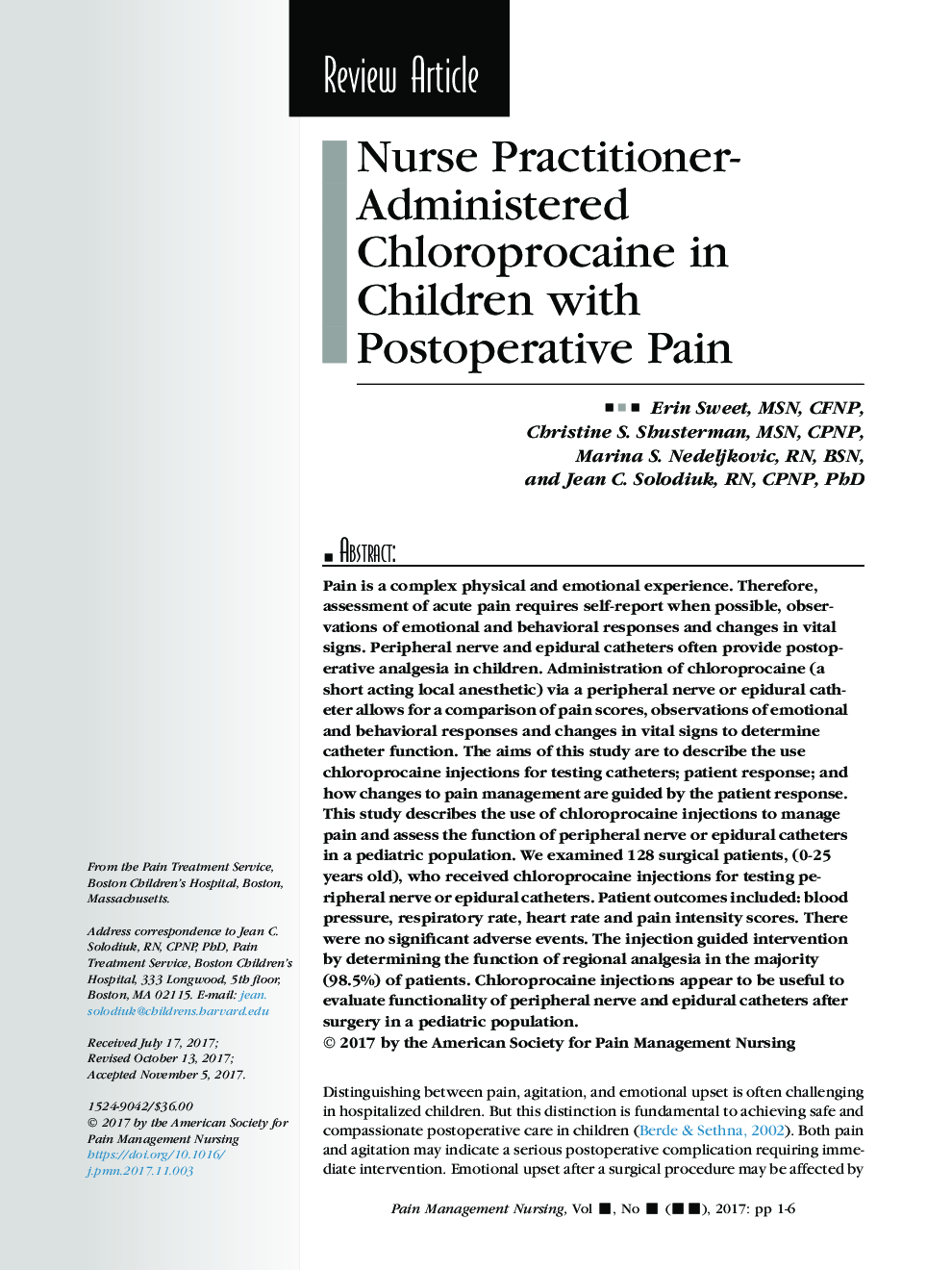| کد مقاله | کد نشریه | سال انتشار | مقاله انگلیسی | نسخه تمام متن |
|---|---|---|---|---|
| 8578713 | 1564430 | 2018 | 6 صفحه PDF | دانلود رایگان |
عنوان انگلیسی مقاله ISI
Nurse Practitioner-Administered Chloroprocaine in Children with Postoperative Pain
ترجمه فارسی عنوان
پرستار تحت درمان با کلروپروکائین در کودکان مبتلا به درد پس از عمل
دانلود مقاله + سفارش ترجمه
دانلود مقاله ISI انگلیسی
رایگان برای ایرانیان
ترجمه چکیده
سابقه و هدف: درد یک تجربه پیچیده فیزیکی و عاطفی است. بنابراین، ارزیابی درد حاد نیاز به گزارش خود را در صورت امکان، مشاهدات پاسخ های عاطفی و رفتاری و تغییرات در علائم حیاتی. عصب محیطی و کاتتر اپیدورال اغلب درد زایمان پس از عمل در کودکان را ارائه می دهند. اعمال کلروپروکائین (یک بیهوشی موضعی کوتاه مدت) از طریق یک عصب محیطی یا کاتتر اپیدورال اجازه می دهد تا برای مقایسه نمرات درد، مشاهدات پاسخ های عاطفی و رفتاری و تغییرات در علائم حیاتی برای تعیین عملکرد کاتتر. اهداف: هدف از این مطالعه توصیف استفاده از تزریق کلورپروکائین برای تست کاتتر ها است. پاسخ بیمار؛ و چگونه تغییرات در مدیریت درد با پاسخ بیمار هدایت می شود. روش ها: این مطالعه توصیفی از تزریق کلروفپراکائین برای کنترل درد و ارزیابی عملکرد عصب محیطی یا کاتتر اپیدورال در یک کودک اطفال است. ما 128 بیمار جراحی (25 تا 25 ساله) که تزریق کلرپروکائین را برای آزمایش عصب محیطی یا کاتتر اپیدورال انجام دادند مورد بررسی قرار دادیم. نتایج بیمار شامل: فشار خون، میزان تنفس، ضربان قلب و شدت درد است. یافته ها: هیچ عارضه قابل توجهی وجود نداشت. مداخله تزریقی توسط تعیین عملکرد بی دردی منطقه ای در اکثریت (98.5٪) بیماران انجام شد. بحث: تزریق کلورپروکائین مفید برای ارزیابی عملکرد عصب محیطی و کاتتر اپیدورال پس از جراحی در یک جمعیت اطفال است.
موضوعات مرتبط
علوم پزشکی و سلامت
پزشکی و دندانپزشکی
بیهوشی و پزشکی درد
چکیده انگلیسی
Background: Pain is a complex physical and emotional experience. Therefore, assessment of acute pain requires self-report when possible, observations of emotional and behavioral responses and changes in vital signs. Peripheral nerve and epidural catheters often provide postoperative analgesia in children. Administration of chloroprocaine (a short acting local anesthetic) via a peripheral nerve or epidural catheter allows for a comparison of pain scores, observations of emotional and behavioral responses and changes in vital signs to determine catheter function. Aims: The aims of this study are to describe the use chloroprocaine injections for testing catheters; patient response; and how changes to pain management are guided by the patient response. Methods: This study describes the use of chloroprocaine injections to manage pain and assess the function of peripheral nerve or epidural catheters in a pediatric population. We examined 128 surgical patients, (0-25 years old), who received chloroprocaine injections for testing peripheral nerve or epidural catheters. Patient outcomes included: blood pressure, respiratory rate, heart rate and pain intensity scores. Results: There were no significant adverse events. The injection guided intervention by determining the function of regional analgesia in the majority (98.5%) of patients. Discussion: Chloroprocaine injections appear to be useful to evaluate functionality of peripheral nerve and epidural catheters after surgery in a pediatric population.
ناشر
Database: Elsevier - ScienceDirect (ساینس دایرکت)
Journal: Pain Management Nursing - Volume 19, Issue 4, August 2018, Pages 424-429
Journal: Pain Management Nursing - Volume 19, Issue 4, August 2018, Pages 424-429
نویسندگان
Erin MSN, CFNP, Christine S. MSN, CPNP, Marina S. RN, BSN, Jean C. RN, CPNP, PhD,
